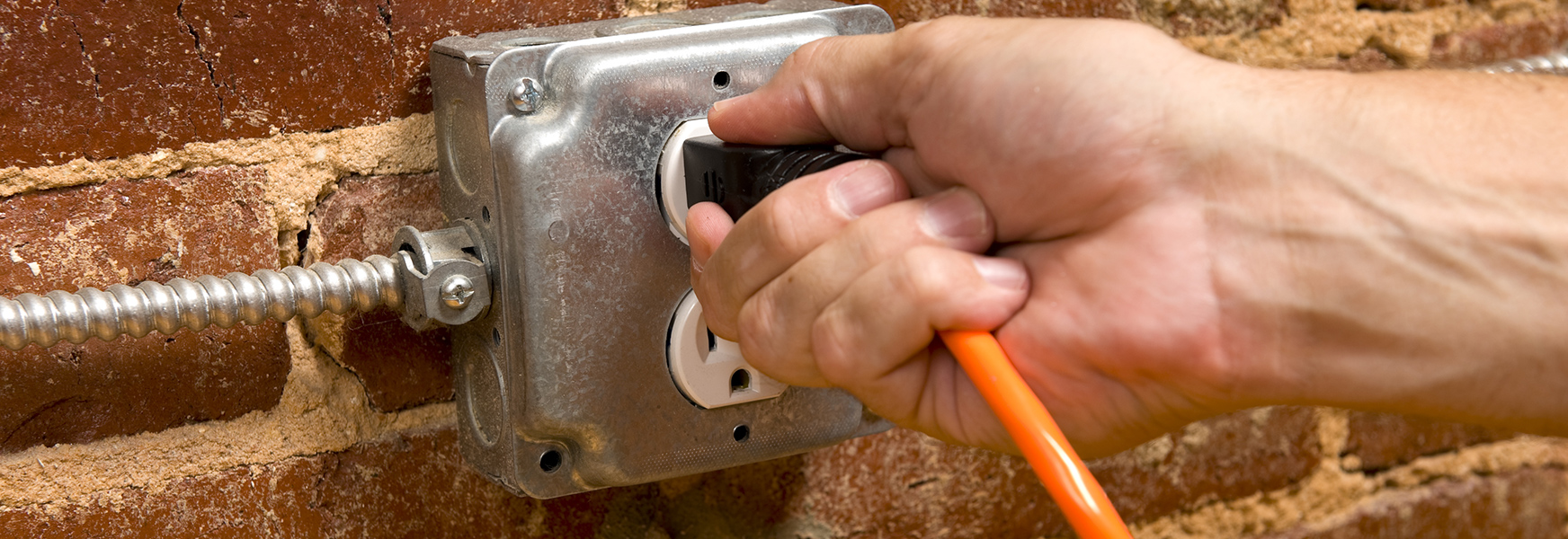Extension Attention! Avoiding Extension Cord Hazards

Extension cords are commonly used items both at home and work. The correct use of an extension cord is an important component to electrical safety efforts.
Proper Extension Cord Use
- Prior to use inspect all extension cords for damage.
- Fully insert the plug of an extension cord into hard-wired outlet.
- Keep extension cord away from standing water.
- Store extension cords indoors away from constant exposure to the sun and weather.
- Unplug extension cords when not in use.
- Only use extension cords temporarily; permanent wiring should be installed when use of the cord is no longer temporary.
- National Electrical Code NFPA Sec. 590.3 (B) Establishes 90 days or less for temporary wiring for holiday decorative lighting and power use. For emergencies, tests, and experiments temporary installation are permitted for the duration of each. [NEC 590.3(A), (B), and (C)]
- National Electrical Code (NEC) does not allow extension cords in lieu of permanent wiring (NEC 400.8(1) – 2014 Version).General rule– if equipment is powered from an extension cord for more than 30 days, permanent solutions should be installed.
- OSHA regulations do permit decorative lighting and similar low voltage set-ups to be used for specific and temporary purposes for a period not to exceed 90 days.
- Purchase only approved extension cords designated by a nationally recognized laboratory, such as Underwriters Laboratories (UL), Intertek (ETL) or Canadian Standards Association (CSA).
- When connecting more than one device to an extension cord add the individual amperage draw of each device together and confirm it does not exceed the cord rating.
- Choose the correct size cord for the job. The NEC sets limits on the amount of current that cords are permitted to carry to prevent overheating. Long wire runs can have a significant effect on the voltage delivered to the appliance. A 100 ft. cord will have twice the resistance of a 50 ft. cord.Common limitations are below:
|
Copper Wire Size Gauge (AWG) |
Current Capacity AMPS |
Recommended Maximum Cord Length |
|
16/2 |
10 amps |
25 feet |
|
16/3 |
10 amps |
25 feet |
|
14/3 |
15 amps |
50 feet |
|
12/3 |
20 amps |
100 feet |
|
10/3 |
30 amps |
150 feet |
- Heavy usage of an extension cord is often an indication that the facility has too few electrical outlets to handle the demand. Additional outlets should be installed where needed.
- Use extension cords according to their markings found embossed on the cord jacket.

|
Designation |
Definition |
Comments |
|
S |
Service |
Service – Flexible, designed for general use |
|
W, W-A |
Weather approved |
Outdoor use |
|
J |
Junior service |
300 Volt Insulation. If no J, the cord is 600V designed for heavier use |
|
T |
Thermoplastic / Vinyl jacket |
|
|
V |
Vacuum Wire |
Softer and more flexible than SJT, usually found on retractable cord reels |
|
P |
Parallel wire construction |
Designed for air conditioners and household use |
|
O |
Oil-resistant |
|
|
OO |
Oil-resistant jacket & insulation |
|
|
E |
TPE jacket |
Elastomer / thermoplastic elastomer rubber (TPE) |
|
SRDT |
Heavy-duty wire |
Specifically for use with higher amperage equipment |
|
HPN |
High-heat parallel neoprene wire |
Used where high-temp appliances could affect cords performance |
|
FT2 |
Flame-retardant |
|
- Exterior-rated cords are the only cords to be used outdoors (W-rated).
- A Ground Fault Circuit Interrupter (GFCI) is required for outdoor extension cord use.It is also required any time an extension cord is used for construction or construction-like activities.
- OSHA Construction: 1926.404(b)(1)(ii) All 120-volt, single-phase 15- and 20-ampere receptacle outlets on construction sites, which are not a part of the permanent wiring of the building or structure, shall have approved ground-fault circuit interrupters for personnel protection.
- OSHA General Industry: 1910.304(b)(3)(ii) Ground-fault circuit interrupters shall be used for personnel protection during temporary wiring installations that are used during construction-like activities, including certain maintenance, remodeling, or repair activities, involving buildings, structures or equipment.
- When unplugging a cord, pull on the plug, not the cord.
- Only use two-wire extension cords with double insulated tools and two-wire appliances.Never by-pass the ground pin on a power cord.
- Use only three-wire extension cords for outdoor use.
Improper Extension Cord Use
DO NOT:
- Use any damaged extension cord.
- Substitute extension cord for permanent wiring.
- Use indoor extension cord in outdoor environments.
- Use an extension cord that has a lower current capacity than the tool being used with it.
- Overload extension cords. Use caution when connecting cords together in a series.Remember Ohm’s Law- voltage equals current times resistance.The longer the cord the more resistance and less amperage the cord can provide.
- Force a plug into an outlet.
- Use a cord if it feels warm or heated during use.
- Drive over cords with vehicles or allow heavy loads to be placed on cords.
- Place cords under rugs or carpets.
- Run cords to create tripping hazards on walking/working surfaces.
- Run through walls, doorways, ceilings or floors.
- Use ground pin adaptors; “cheaters” that convert a 3-wire plug to fit a 2-wire extension cord.
- Use a 3-wire cord that is missing the grounding pin on the plug end.
- Do not use extension cord to power heating units.
- Plug extension cords into power strips.
- Secure extension cords with conductive material.(nails, staples, wire)
For additional information check out MEMIC’s resources within the Safety Director, or tune into the MEMIC Safety Experts Podcast wherever you get your podcasts.

